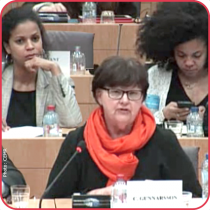Home /
News /
In-depth news /
Cohesion policy
next > < previous

Cohesion policy

Cohesion policy - 01.03.2017
5 proposals for an inclusive, decentralised and simplified future
“EU citizens live in towns and cities of all shapes and sizes. For all citizens to be included, cohesion policy should ensure small towns and large cities are involved when designing investment priorities and delivering EU funds.” Mayor of Sala and CEMR spokesperson on cohesion policy Carola Gunnarsson laid out CEMR’s vision for the future of cohesion policy in a speech delivered at the European Parliament on 28 February.
Carola Gunnarsson put forward European local governments’ 5 proposals for the future of cohesion policy. By taking on these proposals, cohesion policy can rhyme with equality and efficiency in Europe’s territories.
1. Create a new post-2020 strategy for Europe
Because beyond just having a vision, it is necessary to give a full strategic orientation to cohesion policy and make EU progress consistent with global progress in this field (such as Habitat III or the Paris climate agreement).
2. Focus on inclusion
No territory should be left behind. The cohesion policy has to work for all European territories, when designing investment priorities and delivering EU funds. This requires a bottom-up approach, stronger central-local working partnerships and a legally binding partnership principle.
3. Devolve decision-making to local governments
They know what their own territories need. This requires a stronger focus on the place-based approach and Integrated Territorial Investments (ITI). Moreover, having one single set of rules for the five funds that make up the European Structural and Investment Funds (ESIF) would be significant progress.
4. Simplify cohesion policy for a maximised use of funds
Too often, towns with smaller capacities struggle to access funds. Simplification and cutting red tape is essential for their access. In fact, during the debate, Commissioner for Regional Policy Corina Crețu called for a simplification of cohesion policy herself.
5. Provide technical assistance for cohesion policy beneficiaries
Technical assistance should also be available to cohesion policy beneficiaries: towns and regions, but also universities or entrepreneurs. In particular, technical assistance would help beneficiaries regarding state aid rules, public procurement and financial instruments.
Carola Gunnarsson put forward European local governments’ 5 proposals for the future of cohesion policy. By taking on these proposals, cohesion policy can rhyme with equality and efficiency in Europe’s territories.
1. Create a new post-2020 strategy for Europe
Because beyond just having a vision, it is necessary to give a full strategic orientation to cohesion policy and make EU progress consistent with global progress in this field (such as Habitat III or the Paris climate agreement).
2. Focus on inclusion
No territory should be left behind. The cohesion policy has to work for all European territories, when designing investment priorities and delivering EU funds. This requires a bottom-up approach, stronger central-local working partnerships and a legally binding partnership principle.
3. Devolve decision-making to local governments
They know what their own territories need. This requires a stronger focus on the place-based approach and Integrated Territorial Investments (ITI). Moreover, having one single set of rules for the five funds that make up the European Structural and Investment Funds (ESIF) would be significant progress.
4. Simplify cohesion policy for a maximised use of funds
Too often, towns with smaller capacities struggle to access funds. Simplification and cutting red tape is essential for their access. In fact, during the debate, Commissioner for Regional Policy Corina Crețu called for a simplification of cohesion policy herself.
5. Provide technical assistance for cohesion policy beneficiaries
Technical assistance should also be available to cohesion policy beneficiaries: towns and regions, but also universities or entrepreneurs. In particular, technical assistance would help beneficiaries regarding state aid rules, public procurement and financial instruments.
Next steps
8 March: CEMR joint event on local finances at the European Parliament
28 March: CEMR event: “Paving the way for a more territorial Cohesion Policy after 2020”
8 March: CEMR joint event on local finances at the European Parliament
28 March: CEMR event: “Paving the way for a more territorial Cohesion Policy after 2020”
 shqiptar
shqiptar български
български hrvatski
hrvatski čeština
čeština dansk
dansk Nederlands
Nederlands English
English eesti keel
eesti keel suomi
suomi Français
Français საქართველოს
საქართველოს Deutsch
Deutsch ελληνικά
ελληνικά עברית
עברית íslenska
íslenska italiano
italiano Gaeilge
Gaeilge latviešu valoda
latviešu valoda lietuvių kalba
lietuvių kalba magyar
magyar македонски
македонски Malti
Malti norske
norske polski
polski português
português română
română Serbian
Serbian slovenčina
slovenčina slovenščina
slovenščina español
español Türkçe
Türkçe svenska
svenska український
український

















































